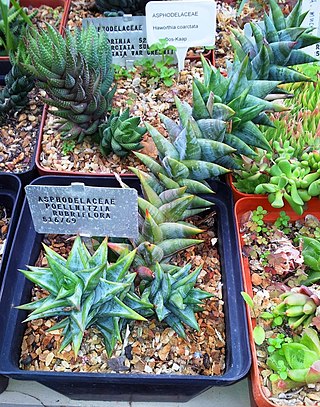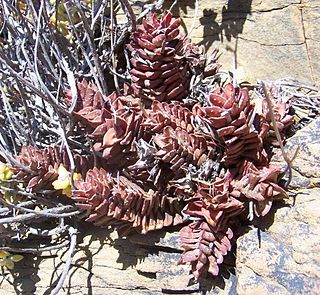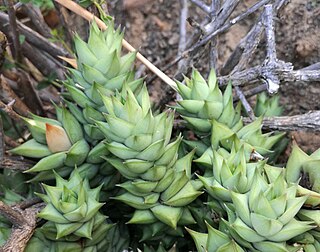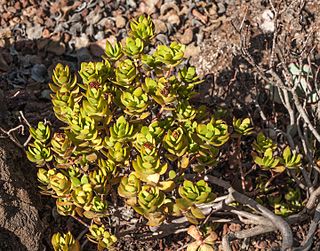
Aristaloe is a genus of evergreen flowering perennial plants in the family Asphodelaceae from Southern Africa. Its sole species is Aristaloe aristata, known as guinea-fowl aloe or lace aloe.

Gasteria is a genus of succulent plants, native to South Africa.

Gasteria excelsa is a succulent plant, native to the Eastern Cape Province, South Africa.

Astroloba rubriflora is a succulent plant found in the mountainous Karoo area around Robertson, South Africa. It is listed as a Vulnerable species on the IUCN global Red List.

Astroloba is a genus of flowering plants in the family Asphodelaceae, subfamily Asphodeloideae, native to the Cape Province of South Africa.

Muiria hortenseae ("mouse-head") is a rare dwarf species of succulent plant of the family Aizoaceae, indigenous to a very small area in the Little Karoo, Western Cape, South Africa. It is the only species in the monophyletic genus Muiria.

Astroloba bullulata is a small succulent plant of the Astroloba genus, endemic to mountainous areas of the southern Cape, South Africa.

Astroloba corrugata is a small succulent plant of the Astroloba genus, endemic to the Little Karoo and the far south of the Western Cape, South Africa.

Astroloba herrei is a small succulent plant of the genus Astroloba, restricted to the area around the Swartberg mountains, South Africa.

Astroloba congesta is a small succulent plant of the Astroloba genus, indigenous to the Eastern Cape, South Africa.

Astroloba foliolosa is a small succulent plant of the genus Astroloba widespread in the arid parts of the Eastern Cape Province, South Africa.

Crassula nudicaulis is a succulent plant native to South Africa, and Lesotho.

Haworthiopsis viscosa, formerly Haworthia viscosa, is a species of flowering succulent plant from the Western and Eastern Cape Provinces, South Africa.

Astroloba spirella is a small succulent plant of the genus Astroloba, restricted to an area of the western section of the Little Karoo, South Africa.

Astroloba robusta is a small succulent plant of the genus Astroloba indigenous to the arid southern Cape regions of South Africa. It is the most widespread Astroloba species.

Astroloba tenax is a succulent plant of the genus Astroloba, indigenous to the Western Cape Province, South Africa.

Crassula cultrata is a succulent plant native to the southern parts of South Africa.

Crassula subaphylla is a succulent plant belonging to the family Crassulaceae. It is widespread in the Karoo regions of South Africa and Namibia.

Crassula biplanata is a succulent plant native to rocky ledges and mountainous areas in the southern parts of South Africa.
Senecio cotyledonis ("Stinkbos") is a species of succulent flowering plant in the aster family, indigenous to the Western Cape and Northern Cape, South Africa.






















